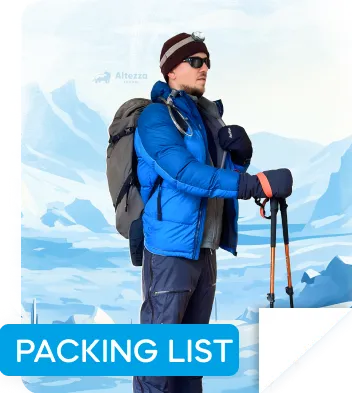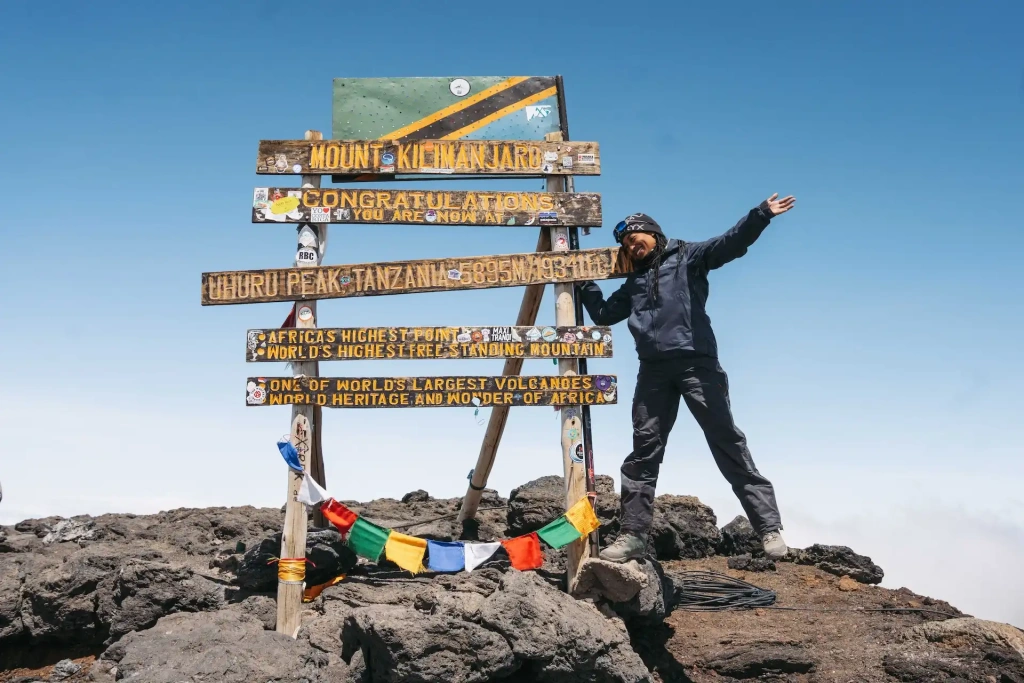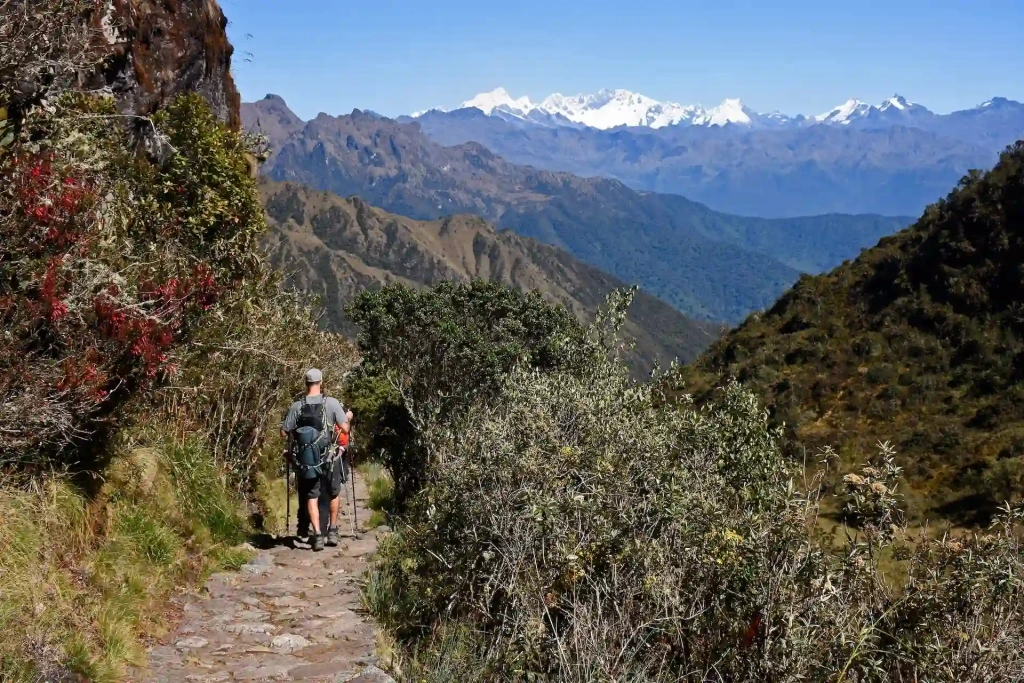Mount Kilimanjaro in Tanzania and the Inca Trail in Peru are often compared as two of the most popular high-altitude trekking destinations. Kilimanjaro offers a journey through multiple climate zones leading to its summit, Uhuru Peak. In contrast, the Inca Trail takes trekkers along ancient pathways, culminating at the famous Machu Picchu. While both routes promise unforgettable experiences, they differ in altitude, physical demands, and the planning required to tackle each.
In this article, we’ll explore these key differences to help you determine which adventure best aligns with your fitness level and preferences.
- From late December to mid-March
- From mid-June to October
Inca Trail and Kilimanjaro: overview
The Inca Trail, 43 km (27 miles) long, runs through the Andes mountain range in Peru. This part of the ancient Inca road leads to the Sun Gate, the entrance to the ancient citadel of u. During the trek, climbers encounter a variety of landscapes, including lush jungles, green valleys, and high mountain passes. Along the way, there are also ancient archaeological sites. The trek is considered moderately difficult and is suitable for individuals with an average physical fitness. The maximum altitude along the trail is 4,200 meters (13,780 feet).
Is Machu Picchu higher than Kilimanjaro?
No, Machu Picchu is not higher than Kilimanjaro. Machu Picchu, the iconic Incan archaeological site in Peru, is located at an elevation of 2,430 meters (7,972 feet) above sea level. Many visitors reach the site by hiking the Inca Trail, which reaches its highest point at Dead Woman’s Pass (Warmiwañusqa) at about 4,200 meters (13,779 feet) before descending to Machu Picchu.
Tanzanian mountain Kilimanjaro stands taller in comparison, with its highest peak, Uhuru, reaching 5,985 meters (19,341 feet). It is the tallest mountain on the continent and one of the renowned Seven Summits, often called the "Roof of Africa." There are eight routes to the summit, each offering its unique challenges and difficulty level.
Which is harder, Kilimanjaro or Inca Trail?
The trek is moderately difficult, meaning you do not need specialized training to climb Kilimanjaro. If you maintain an active lifestyle, you are likely prepared for this adventure.
Nevertheless, it’s important to be in good physical shape to manage the long hours of daily hiking. As the altitude increases, so does the risk of altitude sickness. The air at the summit is thin, meaning each breath provides less oxygen. This can sometimes lead to dizziness, headaches, and nausea. Fortunately, professional guides accompany trekkers throughout the journey, carrying oxygen tanks and first aid kits. They always have altitude sickness medication like Diamox to help you if you feel unwell.
Another notable aspect of ascending Kilimanjaro is the change in climate zones. The tropical forests at the mountain's base can be humid and hot, while the alpine desert zone tends to be cool and windy. The Arctic zone promises an even cooler ascent to the summit. As a result, tourists need to adjust their clothing and hiking gear during the trek. Fortunately, this isn’t a major concern for trekkers because porters carry most of the equipment.

Inca Trail, Peru
The route's difficulty depends on each individual's physical fitness and expectations. Nevertheless, this trail is classified as moderately difficult. Trekkers typically begin acclimating at around 4,000 meters (13,120 feet), a process that usually takes one to two days. Some tours offer day trips for those who want to experience a portion of the trail beforehand and make sure they’re comfortable with the ascent.
The highest point on the Inca Trail is considerably lower than Kilimanjaro’s summit. However, the trek to Machu Picchu involves many steep ascents and descents, countless stone steps, and can be affected by challenging weather conditions. This route can be difficult, but anyone with moderate fitness can handle it given determination.
What is the best time for trekking?
Kilimanjaro
The ideal time to climb Kilimanjaro is during the dry seasons, which occur twice a year: late December to mid-March and mid-June to October. These periods are characterized by clear weather and minimal rainfall.
Remember that these dry-season months are also peak times, so the slopes can be quite crowded with other tourists. That said, tours to the summit run year-round, including during the rainy seasons. In these off-peak periods, tour prices are often lower, and you’ll typically encounter far fewer climbers. If you don’t mind tropical rains at the base and would like the rare experience of seeing snow atop Kilimanjaro, consider planning your trek from late March to early June or in November.
Inca Trail
Like Kilimanjaro, the best time to hike to the Machu Picchu's Inca Trail is during the dry season, which lasts from May to September. The weather along the route is generally sunny, but rain can still occur. Sometimes, it can be foggy at higher altitudes. During the trek, tourists enjoy the landscapes of the valley and surrounding mountains. However, the dry season is the busiest, and you must book your tour almost a year in advance. Alternatively, you can consider hiking during the shoulder season, for example, in April or October. During this time, you have a good chance of encountering favorable weather.
How many routes are available?
Kilimanjaro
If you decide to walk up mountain Kilimanjaro, you’ll have eight routes to choose from: Lemosho, Machame, Marangu, Rongai, Northern Circuit, Umbwe, Kilema, and Western Breach. Many of these trails converge at a certain point. Rongai and Northern Circuit share a common intersection on the eastern slope. Similarly, Lemosho, Machame, and Umbwe come together at Barranco camp.
The duration of the ascent varies from 5 to 10 days, based on the chosen route and specific tour details. For beginners, we highly recommend selecting longer programs of at least 7 days, which allow for a more gradual acclimatization process.
Inca Trail
You can trek the Inca Trail via one of three routes: Mollepata, Classic, and One-Day. The first option involves the longest trek with the highest mountain pass. All three main routes of the Inca Trail intersect at certain points, though the Classic route is known to be the busiest. Completing the trek on this route generally takes 4 to 5 days, depending on the daily hiking pace and rest stops.
Travelers can use shower facilities and toilets and stay in specially equipped huts and shelters along the way to Machu Picchu. Like the Kilimanjaro climb, they are accompanied by guides, porters, and even horses.
How to get to the starting point of the trek?
Kilimanjaro
Many international airlines, including Turkish Airlines, Qatar Airways, KLM, Ethiopian Airlines, Air France, and Swiss International Air Lines, offer regular direct flights to Kilimanjaro Airport (JRO). It's only about an hour from the airport to Moshi or Arusha. Both towns lie in the Kilimanjaro region and offer travelers a chance to rest after the flight, giving them time to recharge before beginning their trek the next day.
For more detailed info on how to get to Kilimanjaro, see our guide.
Inca Trail
Jorge Chávez International Airport in Lima, the capital of Peru, is served by most international airlines, including Air Europa, Air France, Sky Airline, United Airlines, and American Airlines. From there, tourists take a one-hour flight to Cusco, where tours along the Inca Trail begin.
Is it better to hike Inca Trail or Kilimanjaro?
There cannot be a clear winner when it comes to hiking Kilimanjaro vs the Inca Trail. Both routes present their own challenges, but either way, you'll be treated to unforgettable experiences. The key difference is that accessing the Inca Trail can be difficult due to restrictions on the number of tourists allowed. In contrast, there are no such limitations for hiking Kilimanjaro, where ascents to Uhuru Peak happen year-round. However, during peak seasons, such as just before the New Year holidays, it's wise to book your tours in advance.
Climbing Kilimanjaro may take longer, but it serves as an excellent test of character and endurance. Even if you’re not a professional athlete and have never hiked at such altitudes, you can still conquer the tallest free-standing mountain in the world. With the right training, a positive mindset, and a reliable tour company, you can overcome any challenges that arise along the way. The team at Altezza Travel is dedicated to ensuring that your journey is filled with positive experiences and lasting memories.
All content on Altezza Travel is created with expert insights and thorough research, in line with our Editorial Policy.
Want to know more about Tanzania adventures?
Get in touch with our team! We've explored all the top destinations across Tanzania. Our Kilimanjaro-based adventure consultants are ready to share tips and help you plan your unforgettable journey.
























